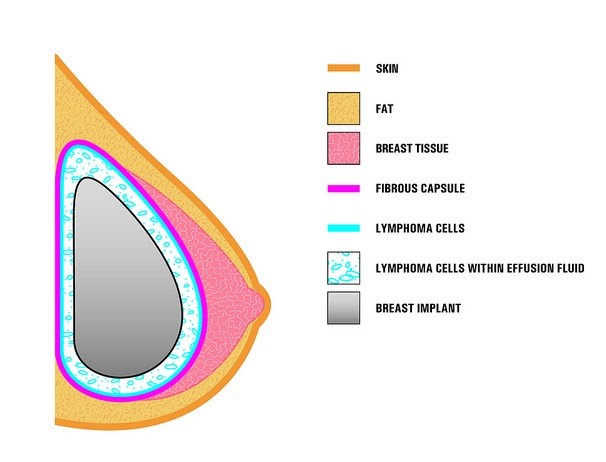Implant Associated Lymphoma Information for Seattle Patients
Also serving Bellevue, Kirkland, & Everett
What is Breast Implant Associated Anaplastic Large Cell Lymphoma (BIA-ALCL)?
BIA-ALCL is a rare type of non-Hodgkin’s T-cell lymphoma (blood cancer) that forms in the scar tissue that normally surrounds a textured breast implant. Although, lymphoma generally affects the body’s lymphatic system, BIA-ALCL is an unusual form of the disease that is almost always limited to the peri-implant tissues and/or fluid (seroma) and does not usually affect other areas of the body. In advanced stages, BIA-ALCL can extend into the breast tissue, surrounding lymph nodes and soft tissues such as muscle, or even metastasize to distant sites.
Is BIA-ALCL a Type of Breast Cancer?
No, BIA-ALCL is a cancer of the immune system and is technically not a tumor of the breast tissue, even though it generally occurs within the breast scar tissue and/or fluid surrounding a breast implant.
What Type of Implants Are Associated with BIA-ALCL?
BIA-ALCL has been associated with both saline and silicone implants, reconstructive breast surgery with implants, as well as cosmetic breast augmentation in both women and men (transgender).
Although the FDA notes that a small number cases of BIA-ALCL brought to their attention via Medical Device Reports were associated with smooth surfaced breast implants, the accuracy and validity of this information has not been verified.
However, formal studies carried out in Australia, New Zealand and the USA and reported in the Journal of Plastic and Reconstructive Surgery in 2018 have shown that all verified and well documented cases of BIA-ALCL have occurred in patients with textured implants.
Are Certain Types of Textured Implants More Likely to be Associated with BIA-ALCL?
Those textured implants with the greatest surface area such as the Biocell and Silimed Polyurethane implants were noted to have the highest rate of BIA-ALCL involvement. This association with textured implants appears to be related to the body’s chronic inflammatory reaction to the irregular surface or possibly to a low grade bacterial colonization (biofilm) of the implant surface.
Does BIA-ALCL only Occur in Patients with Capsular Contractures?
No, BIA-ALCL has been seen in patients with and without capsular contractures of their breast implants (thickened, tight, and painful scar band that sometimes forms around an implant).
Has BIA-ALCL been Associated with the ideal Breast Implant?
No, ideal Implants have a smooth surface and there have been no known cases of BIA-ALCL in patients treated with this type of implant.
How Common is BIA-ALCL?
Recent studies have estimated the incidence of BIA-ALCL to be between 1:1000 to 1:30,000 in patients with textured breast implants.
Since the first case report in 1996, a total of 518 cases have been confirmed worldwide, with 194 cases occurring in the U.S. as of February of 2018.
How Long After Implant Surgery does BIA-ALCL occur?
Most cases occur between 7 and 10 years following surgery (range of 1-37 years).
How Do I Know if I have BIA-ALCL?
If you have undergone breast augmentation with textured implants and have had an unexplained increase in the size of one breast, asymmetry, collection of fluid around your implant or a lump in your breast or armpit, you should seek the advice of a board certified Plastic Surgeon.
How is a Definitive Diagnosis of BIA-ALCL made?
Peri-implant fluid detected by diagnostic ultrasound or MRI will be aspirated and tested for CD30 immune staining (CD30IHC) which if positive, establishes the diagnosis of BIA-ALCL.
Are there Different Types of BIA-ALCL?
Yes, the most common type is the “effusion” type which is localized to the immediate peri-implant tissues and/or fluid. The other form of BIA-ALCL is associated with a solid ALCL tumor mass in the breast, which can sometimes extend into the surrounding structures such as the pectoralis muscle.
Is BIA-ALCL Treatable?
Yes, the great majority of cases of the “effusion” type BIA-ALCL are successfully treated with implant removal and concomitant capsulectomy (removal of the capsule or scar tissue surrounding the implant). Both implants should be removed since there is a small, but an increased chance of the opposite breast eventually being affected.
Conversely, the small number of patients presenting with a solid ALCL tumor mass are more difficult to cure.
What is the Overall Prognosis for patients with BIA-ALCL?
The overall prognosis for those treated for the “effusion” type of BIA-ALCL is excellent. However, patients presenting with a solid ALCL tumor mass have a 25% mortality rate at 5 years following their diagnosis. Treatment for more advanced cases may include chemotherapy, radiation treatment, or rarely stem cell transplant therapy.
Although a small number of fatalities have been reported in patients with BAI-ALCL due to advanced, uncontrolled disease, the overall risk of dying from BIA-ALCL has been reported to be about 1 in a million.
What Should You Do?
If you notice an unexplainable swelling of a breast or a mass following augmentation, you would be wise to have it checked by your surgeon, keeping in mind however that the great majority of breast implant patients with these types of symptoms will not have BIA-ALCL.
Otherwise, you should do nothing other than remain vigilant of suspicious changes in your breasts and well informed regarding any updates of BIA-ALCL.









